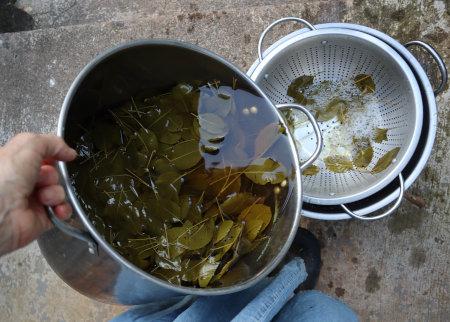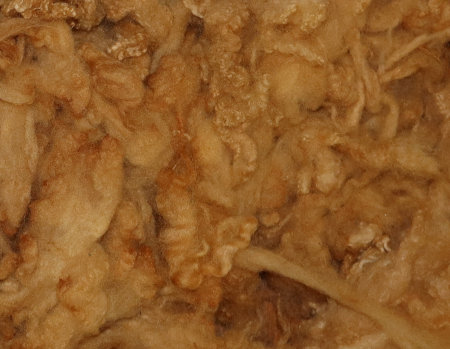After two dyeing projects that took repeated simmering and steeping to extract
the color, I was ready for something a little simpler. I reckon natural dyeing
is a summer project for me, when fresh plant material is widely available. I'm
trying to take advantage of seasonal resources while I can. The directions for
using pear leaves came from Jenny Dean's Wild Color.
Her recipe calls for at least equal weight of leaves to fiber. More, for
stronger color. Color can be extracted by either cold soaking or simmering. I
will have to try the cold method sometime, but for now, I'm thinking I'd get
stronger color with heat, so that's what I opted to do.
Day 1: Making the dyebath
- Dyebath amounts should be at least 1:1 for leaves to fiber. I used:
- 12 ounces pear leaves for 8 ounces fiber
- 2 gallons water
- Pour boiling water over the leaves and let sit.
- Or, place leaves in several gallons of water, bring to a boil, and simmer for an hour or two.
- Let steep overnight until cool.
Note: the leaves smelled like cooking spinach while they
simmered.
Day 2: Dye day
- Strain out the leaves (and save for another dyeing experiment).
- Add thoroughly wetted, mordanted fiber to the pot. (I used alum and cream of tartar.)
- Simmer for 30 to 60 minutes or so, until desired color is reached.
- Let steep overnight until cool.
Day 3
- Remove the fiber
- Wash with mild dish detergent and rinse until the water is clear.
- Squeeze out excess water (or run through the spin-only cycle in the washing machine) and lay out to dry.
The bark of the pear tree can also be used for dyeing and gives
pinkish/purplish colors. I'll have to give that a try sometime in the
future. Next, however, I wanted to experiment a bit with this dyebath and see what other colors I could get.
© Aug 2024 by Leigh at Leigh's Fiber Journal
Related posts





6 comments:
Natural dyeing certainly can be surprising! Never expected green leaves to give you 'peach'!
Michelle, it's extremely fascinating. My further experiments with it were equally surprising (next time). I need to start compiling a list of locally available plants and the colors I can get.
Pear leaves. I had no idea. Are other fruit tree leaves discussed?
TB, yes. Apparently apple leaves will give a yellow dye. As will oak leaves and yellow poplar. There are more, I think, but I don't have a convenient list. I need to make my own list of the colors I can get from local plants. It would be a useful reference.
I've done apple leaves in an iron pot and got a really great green! I love the colour of your pear leaves; soft and pretty. I tend to not both with cream of tarter as I only use alum at 10%, so much less likely to give any harsh effects to the fibre and cream of tarter is also a PH modifier and can sometimes give dramatic shifts to colour. Sometimes you want that though.
Nina! I'm thrilled to find your comment and get your input. I was really happy with the pear leaf experiments. Next year I'll try it with some iron. Next year I plan to try apple leaves as well. This summer's experiments really excited my interest.
I did not know that about the alum and cream of tartar. Good to know! One of my books uses smaller amounts of both alum and CT, which I reckoned is the stuff of future experiments too. I really appreciate your experience and information.
Post a Comment